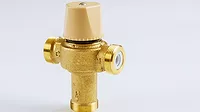Conversion Experience
John Siegenthaler, PE


The vast majority of formulas used in the North American hydronics industry are based on customary U.S. units. However, on occasion you may have an opportunity to read through technical specifications or design guidelines from the European hydronics market. Although there’s no difference in the physics of hydronics in Europe vs. the United States, there is definitely a difference in the units of measurement, and this means different constants will be used in their design formulas.
Having the ability to quickly convert from European units to customary U.S. units lets you get a better feel for the information being discussed. For example, how many of you can “picture” a 28 kilowatt oil-fired boiler? Would such a boiler be typical in a residential application or is it a large boiler more typical of a commercial job? Perhaps your first reaction to the words “28 kilowatt oil-fired boiler” was that the column contains a typo because the unit Kilowatt applies to electricity rather than fuel oil.
To get a feel for a 28 kw boiler, you must first realize that the unit kilowatt (kw) is associated with the physical concept of power. Power is the rate of energy flow; for example, how much energy passes from one location to another in a given amount of time. The energy that’s moving can be in any form - mechanical, thermal or electrical. The energy might even change form as it moves. An example of the latter would be electrical energy converted to thermal energy within a space heater.
The customary U.S. units for expressing boiler output are Btu/hr - the number of Btus the boiler delivers during one hour, assuming constant operation. Btu/hr is, thus, a rate of energy flow and, as such, a valid unit for power.
Any unit of power can be converted to any other unit of power. This is also true for other physical quantities such as length, time, weight, voltage, distance, etc. Making such a conversion is simply a matter of looking up the conversion factor between the units you have and the units you want to convert to. In this case, the conversion factor is: 1 kw = 3,413 Btu/hr. You can find these unit conversion factors in many textbooks, ASHRAE handbooks, or engineering reference books.
Today, you can also go online to find unit conversion factors (check out www.onlineconversion.com). This Web site makes it really simple. Just type in what you want to convert, along with the starting units, and select the units you want to end up with. The site understands the physical quantity you’re dealing with and lists a selection of appropriate units into which you can convert the starting quantity. In the context of the boiler power rating, it converts 28 kw to 95,539.965783726 Btu/hr.
Don’t get carried away with all those numbers to the right of the decimal point. They are essentially meaningless, given that the starting quantity is only known to two significant digits (28 kw vs. 28.000000000 kw). For most calculations needed in hydronic system design, it’s fine to round off to three significant figures. Thus, 95,539.965783726 Btus/hr gets rounded off to 95,500 Btus/hr.
Suppose you find yourself needing to convert units and you don’t have access to this Web site. Well, based on last month’s column, you can do your own math as shown in the following formula:
Remember to set up the unit conversion factor as a fraction with the units you want to eliminate, located so they cancel each other out in the top and bottom part of the fraction.

Euro Units
Here’s a listing of conversion factors you’re likely to need in converting quantities from European to customary U.S. units. In each case, the physical quantity is stated (e.g., heat, power, flow rate). This is followed by a formula in which the customary U.S. unit appears on the left side of the equal sign along with a value of 1. To the right of the equal sign are one or more metric equivalents for that unit. For example, in the case of heat:


Powers Of 10
One of the things you eventually learn to love about the metric system is that different units are often related to each other based on powers of 10. For example, in the case of length:The following prefixes are commonly used in metric units for quantities involved in hydronic heating systems:
1,000,000 = mega
1,000 = kilo
0.01 (one hundredth) = centi
0.001 (one thousandth) = milli
0.000001 (one millionth) = micro
If you work with numbers, especially from European publications, it’s wise to memorize these prefixes. Doing so lets you do some quick conversions without ever reaching for a calculator.
Dealing with unit conversion is a fundamental requirement of working in any technical field. Knowing proper unit conversion techniques is essential, especially when you have little “practical feel” for the quantity you are dealing with. For example, if I were told the pressure in my truck tires was 206,000 pascals, I would have no idea if that were high, low or ideal. I would have to trust the unit conversion method to convert this to something I can relate to. In this case, 206,000 pascals converts to 30 psi.
I hope the data and methods presented here will help you “get a feel” for quantities, concepts and products that are simply measured differently. See you back here in about 2.59 megaseconds…
Looking for a reprint of this article?
From high-res PDFs to custom plaques, order your copy today!





